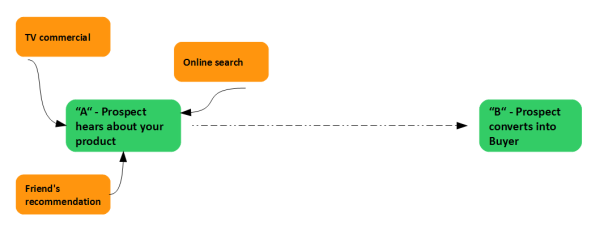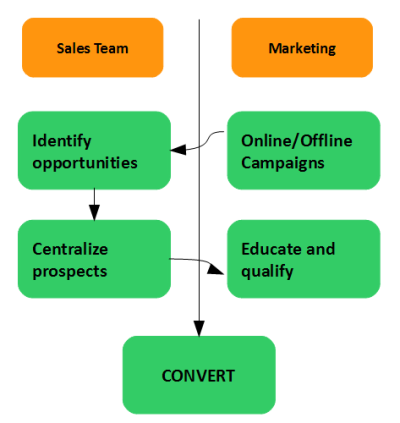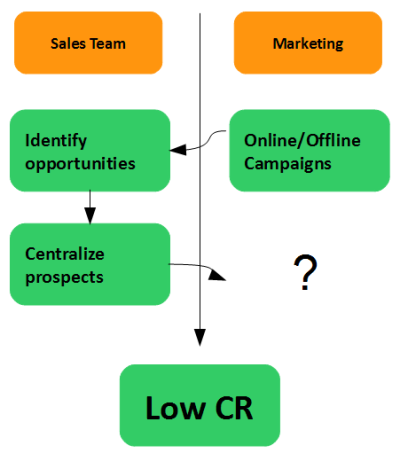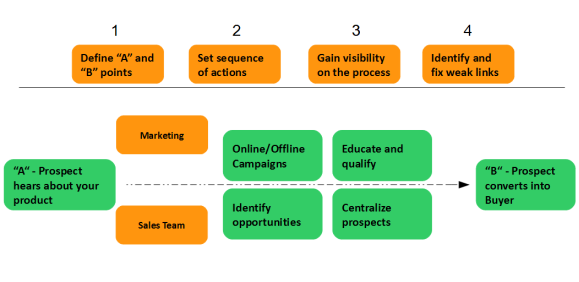In today's competitive business environment, revenue growth rarely happens by accident. While steadfast determination and successful project management play integral parts, putting in place an efficient revenue chain represents a key facet to any successful operation.
It is therefore important to help ensure a consistent and sustained growth considering a step by step approach.
In this article, I will present a diagram with the steps you can take in defining the revenue chain for your business. Here is how it looks like:
-
Determine Your A And B Points
The initial step is to determine the exact point where a potential buyer encounters your product and the point of conversion where this prospect is converted into a buyer (the point of sale).
 What is important here is to focus on your relationship, as the seller, with the prospect.
What is important here is to focus on your relationship, as the seller, with the prospect.
The initial interaction is very important as it represents the first, nurturing step where a sound business relationship may begin. By determining where exactly the prospects are coming from, their respective demographics and specific needs, you have the chance to enter into a successful campaign and begin a healthy conversion process.
In essence, this first step defines the beginning and end of a sales lifetime.
-
Set The Sequence Of Actions In Your Revenue Chain
At this point in defining the revenue chain, your need to consider the finite sequence of actions in growing the raw leads into a productive and sustainable revenue driving mechanism. Here are the main actions you should keep in mind:
- Identify the opportunities from your marketing campaigns
- Capture the prospects into a management system
- Nurture the leads
- Convert the qualified prospects into buying customers
Of initial concern is observing the efficacy of targeted marketing strategies; responsiveness to specific types of advertisement and lead generation, for instance. You need to observe and collate respective data from both active campaigns (outbound sales calls, follow-ups, etc.) as well as automated services such as email replies, the number of blog or social media followers and similar standalone services.
These leads should then be "quantified" into an efficient and centralized data management system. These customer relationship management systems (otherwise known as CRM's) abound and are widely implemented for direct management of the seller/buyer relationship. They can help effectively manage all areas of the business's relation with the clients, ranging from the initial close of sale to actively overseeing existing client engagement.
Although implementing a successfully automated CRM is of fundamental importance, properly qualifying the potential leads directly results in higher conversion rates. This qualification must encompass various aspects of nurturing and strengthening the business relationship.
Just as well, trust is an important factor that must be developed and proactively pursued through product education, proper financial screening, offers for informative sessions such as webinars or other real-time interactive tools and addressing both inbound and outbound customer support calls.
-
Gain Overall Visibility Of The Chain
Actions under Step 2 are only successfully employed when the entire process is visible; that is, when a centralized and easily administered system is used to allow the sales and marketing teams to work together.
 This cohesion is necessary to help guarantee successful management of the current revenue stream as well as to make any adjustments should a certain strategy or template need to be implemented on-the-fly.
This cohesion is necessary to help guarantee successful management of the current revenue stream as well as to make any adjustments should a certain strategy or template need to be implemented on-the-fly.
-
Identify And Fix The Weak Links
When a prospect is appropriately qualified, all efforts should be focused into converting the prospect into a buying customer. Yet this process should be observed much like the links of a chain; should one link break, the chain inevitably fails.
 Strengthening these links equates to addressing questions and concerns along the entire closing process. Therefore, you need to have an innate knowledge of both the qualitative side of the product (such as advantages and support structure) and the quantitative aspects (price, legal issues or contractual obligations).
Strengthening these links equates to addressing questions and concerns along the entire closing process. Therefore, you need to have an innate knowledge of both the qualitative side of the product (such as advantages and support structure) and the quantitative aspects (price, legal issues or contractual obligations).
When such links are firmly established, the percentage of closed clientele is much higher than if one employs a weak conversion strategy. Clarity is the key.
All these steps together help you establish a constant, sustained growth in your revenue. While this process should be concise and effective, internal analyses from both a sales and marketing standpoint should be consistently performed to address any need for adaptations in the revenue chain itself.
Without such analyses, customers may be lost due to dissatisfaction, new prospects may be squandered due to incorrect marketing campaigns and the entire process may come to a grinding halt resulting in loss of revenue.
Back To You
This article approaches only the basic steps in defining a revenue chain. Depending on the type of business you are running, each step includes different value driving strategies. I'd love to read about your personal experiences in the comments section below.
If you liked this post, you might also enjoy 6 Ways To Make SEO Your Company's Second Nature

